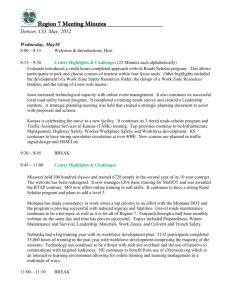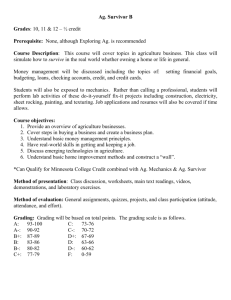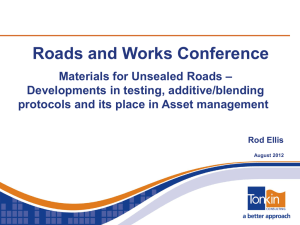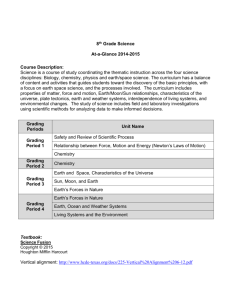WET OR DRY?
advertisement
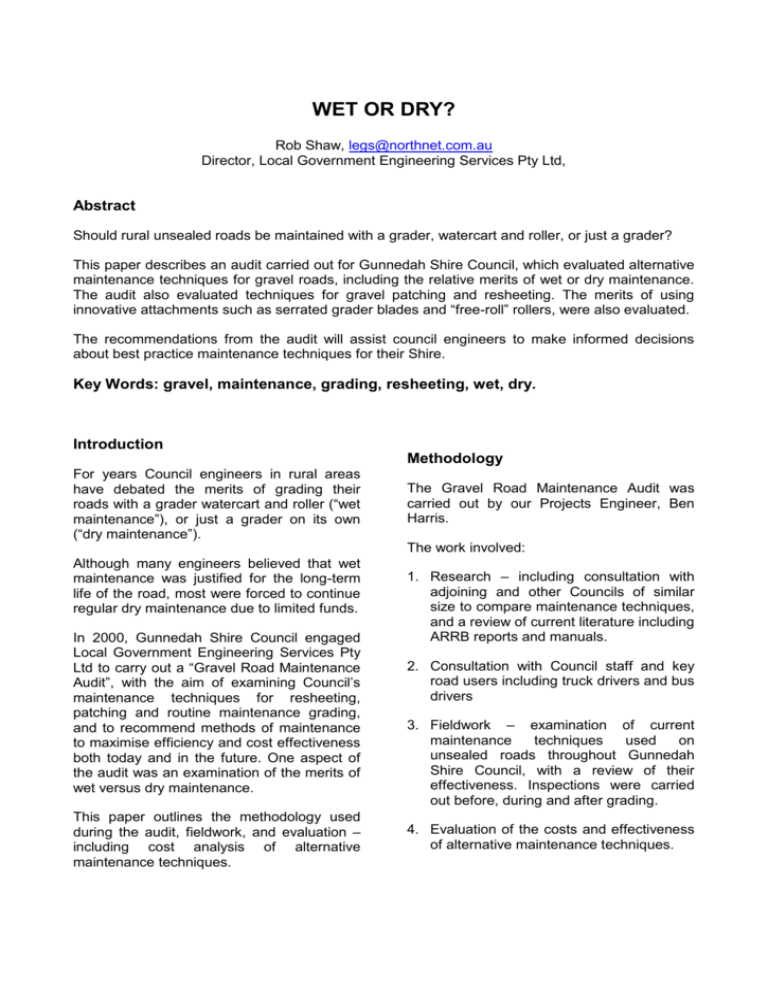
WET OR DRY? Rob Shaw, legs@northnet.com.au Director, Local Government Engineering Services Pty Ltd, Abstract Should rural unsealed roads be maintained with a grader, watercart and roller, or just a grader? This paper describes an audit carried out for Gunnedah Shire Council, which evaluated alternative maintenance techniques for gravel roads, including the relative merits of wet or dry maintenance. The audit also evaluated techniques for gravel patching and resheeting. The merits of using innovative attachments such as serrated grader blades and “free-roll” rollers, were also evaluated. The recommendations from the audit will assist council engineers to make informed decisions about best practice maintenance techniques for their Shire. Key Words: gravel, maintenance, grading, resheeting, wet, dry. Introduction Methodology For years Council engineers in rural areas have debated the merits of grading their roads with a grader watercart and roller (“wet maintenance”), or just a grader on its own (“dry maintenance”). The Gravel Road Maintenance Audit was carried out by our Projects Engineer, Ben Harris. The work involved: Although many engineers believed that wet maintenance was justified for the long-term life of the road, most were forced to continue regular dry maintenance due to limited funds. In 2000, Gunnedah Shire Council engaged Local Government Engineering Services Pty Ltd to carry out a “Gravel Road Maintenance Audit”, with the aim of examining Council’s maintenance techniques for resheeting, patching and routine maintenance grading, and to recommend methods of maintenance to maximise efficiency and cost effectiveness both today and in the future. One aspect of the audit was an examination of the merits of wet versus dry maintenance. This paper outlines the methodology used during the audit, fieldwork, and evaluation – including cost analysis of alternative maintenance techniques. 1. Research – including consultation with adjoining and other Councils of similar size to compare maintenance techniques, and a review of current literature including ARRB reports and manuals. 2. Consultation with Council staff and key road users including truck drivers and bus drivers 3. Fieldwork – examination of current maintenance techniques used on unsealed roads throughout Gunnedah Shire Council, with a review of their effectiveness. Inspections were carried out before, during and after grading. 4. Evaluation of the costs and effectiveness of alternative maintenance techniques. Pre-grading inspections Seven roads were inspected prior to grading. In general, most of the roads examined were in sound condition, apart from the areas requiring resheeting, but corrugations were present on most roads. Rutting was common on many of the roads either due to insufficient gravel on the road or gravel that had ravelled due to insufficient compaction. Photo 2 - Mullaley – Boggabri Road Note the excessive width of the road which requires additional passes and frequent grading. There are also no guideposts to restrict the width to which the graders work. Also the crossfall of most roads appeared to be insufficient when compared to the suggested minimum of 4% (ARRB, 1993). Inspections during grading Photo1 – Bulga Road. Note the amount of loose material on the bend and the large rocks left after the fine material is lost either to the sides or as dust. The most widespread concern in Gunnedah Shire is dust and the large amounts of loose material formed as windrows between wheel tracks. These windrows were in some places 50 – 100mm deep. This loose material shows an accelerated rate of loss of gravel from the road as it is either being thrown off by the tyres or blown away as dust. The width of the roads was also noted as a cause of concern, as some unsealed roads are up to 15 metres wide. This has come about from a combination of the gravel being pushed to the side by the passing traffic and the graders working beyond the original road width. This is a common problem with the dry grading technique and should be avoided because it increases the area of road to be maintained and encourages excessive speeds on straight roads. Drainage appeared to be a problem, with many of the roads having table drains either blocked with sediment and plant growth or having a windrow of material stopping the water from entering the drain Four roads were inspected during grading. The inspection was carried out after overnight rainfall, and the gravel at the time was damp but still well below optimum moisture content. Photo 3 – Breeza - Piallawa Road. Grading in operation utilising the free-roll. Note the moisture in the gravel and the standing water in the table drain. Despite the good moisture conditions at the time of the audit, the lack of a roller in most locations resulted in an excessive amount of loose material on the pavement as shown in Photo 4. In general the roads were graded to a flat formation with very little crossfall. The most common grading technique was to make three passes from left to right, windrowing the material on the right side of the road. Four passes were then made back to the left, backspreading the material with each pass. A better technique is to make two passes up each side of the road, windrowing the material in the centre. Four passes are then made from the centre to the sides (two passes each side) backspreading the material with each pass. This technique, although requiring one additional pass, creates a better crossfall on the road and minimises width by depositing excess material on the centre, rather than the shoulders. It also ensures that an even number of passes are used which eliminates the need for the grader to make a pass down the centreline, thus not cutting the crown of the road. Photo 4 – Carroll - Breeza via Clifton Road. Shows the condition of the surface at the completion of grading. Note the amount of loose material on the surface and the windrow blocking flow to the table drain. Inspections after grading The same roads previously inspected were inspected again after grading. The roads all appeared to be in good condition, with a smooth relatively defect free riding surface. But there was already loose material on the surface and potholes were filled with loose poorly compacted gravel. Crossfall and width were still noted as a potential problem. Photo 3.5 – Mullaley – Boggabri Road. Shows the condition of the surface after grading. Note the amount of loose material on the surface and the potholes which are filled with dry loose material Patching Photos 3.6 – 3.8 show the patching method being used by the contractors hired to carry out routine patching on the roads. The method observed was to run the material out of the truck, with thickness controlled by truck speed. Once spread, the material is rolled with the truck wheels. When possible this patching is done just ahead of the maintenance grader, which correctly shapes the patch. This method is effectively used as an interim measure to keep the road serviceable prior to the next resheeting cycle or to simply correct isolated weak spots in the pavement. In general, this system seems to be extremely effective in keeping the gravel roads in a sustainable condition. The only causes of concern were: 1. Control over the amount of gravel being placed on each patch is limited with either a half or full load being placed on each patch. 2. Poor compaction due to the variation in gravel thickness and the lack of a watercart and roller. Photo 3.6 – Warboys Road. Previously identified failed location prior to patching Photo 3.9 –Coocooboona Road. Shows the use of patching to keep the road serviceable. Note the potholes due to a flat formation and lack of compaction at the time of placement Versatility Attachments Photo 3.7 – Warboys Road. Gravel placed on the failed section by running out of a moving truck With one plant item required to perform a range of duties, grader attachments that improve versatility are increasing in demand. Two attachments which have been or are currently under trial at Gunnedah are the “Free-roll” roller attachment, and serrated grader blades. Free-roll Photo 3.8 – Warboys Road. Gravel being rolled by the wheels of the empty truck Resheeting Council’s resheeting programme is carried out with a grader, roller(s) and watercart. No gravel resheeting work was observed during the audit. At the time of the audit, Council was trialling a Free-roll attachment (Photo 3.3) on one of the graders. Photo 3.10 shows that the roller produced a smoother and tighter crust on the surface which will hold together better under traffic and retain moisture longer. Closer examination of the surface showed that while the top was reasonably well compacted, the low moisture content prevented full compaction further down. Just the same, the operator claimed that using the Free-roll would generally lead to approximately four weeks longer life between gradings. Photo 3.10 – Breeza – Piallawa Road. Shows the point at which the free-roll is applied to the graded road. Note the greatly improved surface due to this compactive effort Photo 3.12 – Conventional Flat Blade. Note the smoothing of the surface which tends to occur and the poor mixing and spreading of the material. Also note the width being worked and relatively flat formation Serrated Cutting Edges Evaluation Most of the graders being used at the time of the audit had serrated cutting edges (or teeth) attached to the blade which scarify the surface, break up larger stones in the pavement and uniformly mix the material. All operators with these blades have been using them for some time and were extremely pleased with the results achieved. Photos 3.11 and 3.12 show the results achieved with the teeth as opposed to a conventional flat blade. As can be seen the conventional blade tends to smooth the cut surface, thus not allowing the backspread material to lock into the surface, while the teeth tend to scarify the surface providing a rough interface to tie the material in. Four maintenance options were evaluated by calculating the whole of life cost for each option over a thirty year life for all of Council’s unsealed road network. Gunnedah Shire Council has 1240km of unsealed roads. Currently on average, each road is graded 4.6 times per year or once every 11 weeks. The four options evaluated were:1. Dry maintenance without a roller (current method) 2. Dry maintenance with Free-roll 3. Wet maintenance with Free-roll 4. Wet maintenance with a self-propelled roller The evaluation assumed that average grading frequency would be reduced to 3.7 times per year for dry maintenance with a Free-roll (Option 2), and 2 grades per year for wet maintenance (Options 3 & 4). Photo 3.11 – Serrated Cutting Edges. Note the well mixed material and the ability of the teeth to lightly scarify the surface The evaluation also included average costs for resheeting over the life of the unsealed road network. Resheeting costs were included every 10 years for dry grading and every 15 years for wet grading. These intervals are considered conservative as the ARRB (2000) report state periods of 5 – 7 years for dry and 20 – 25 years for wet. The table in Appendix A shows the calculation of whole of life costs for maintenance of Gunnedah Shire Council’s unsealed road network over a 30 year period. Conclusions From the whole of life cost analysis, the two wet maintenance options are the cheapest over 30 years due to the reduced resheeting cycles required. The question of which roller to use depends on the material, but for the purposes of this audit, using the Free-roll produced the lowest whole of life cost. It was noted that these life costings reflected the findings of the ARRB(2000) report. Gunnedah Shire Council currently operates a dry maintenance technique on a cyclic rotation around defined areas within the shire. This audit found the following points of concern with this technique: Excessive amounts of loose material were on the road surface even shortly after grading. Major roads were too wide. The formation appeared too flat with insufficient crossfall. These concerns can all be traced at least partially to the dry maintenance practice. The excess loose material is a direct result of inadequate compaction and low moisture content. Dry maintenance increases the road width because passing vehicles push loose material out, and the graders work beyond the original road formation to salvage fines from the roadsides. Gunnedah Council’s grading technique of making successive passes from the left to right windrowing the material on the right hand side of the road, then backspreading in the opposite direction, results in excess material being left on the sides, not on the centre. This procedure results in a flattening of the crown of the road, and inadequate crossfall. The major problem found with the gravel roads was the amount of loose material on the surface, which is a symptom of the dry maintenance methods used. While being the cheapest way to grade a road in the short term, it was shown to cost more in the longer term than wet maintenance methods. Two major contributing factors to this is the frequency in which resheeting is required and the frequency in which routine grading is required. By adopting a wet maintenance technique although additional initial capital outlay may be required, the resheeting requirements of each road will be reduced in the longer term and each road would require grading less often in the shorter term. Recommendations It was recommended that Council adopt a wet maintenance strategy, utilising a free-roll where suited to the materials and either a drawn or self-propelled vibrating roller where required. It was also recommended that the use of serrated cutting edges on the grader blades should be retained. With regard to other issues raised in the audit, the following recommendations were made: Crossfall of most roads should be increased to a minimum 4%. Graders should operate with an even number of passes to avoid cutting over the centreline, removing the crown of the road. Acknowledgements Tim Page, Manager Engineering Services, Gunnedah Shire Council, for permission to publish the results of the Gravel Roads Audit. Ben Harris B.E.(Hon), Projects Engineer, Local Government Engineering Services Pty Ltd, who carried out all of the research and fieldwork, and prepared the audit report. References Australian Road Research Board (1993), Unsealed Roads Manual – Guidelines to Good Practice. ARRB Transport Research Ltd. South Vermont, Victoria. Australian Road Research Board (2000), Pavement and Drainage Maintenance Procedures: Environmental Best Practice. ARRB Transport Research Ltd. South Vermont, Victoria. Bryant M.J. (1997), Report on Plant Requirements and Production Rates for Gunnedah Shire Council. Gunnedah Shire Council, NSW. Morris, P.O. and Tynan, A.E. (1988), Final Report on “Free-roll” Compaction Roller. Public Works Engineering (July/August 2000), Unsealed Roads – Maintenance and Drainage Considerations. Institute of Public Works Engineering Australia. Transport South Australia – Materials Technology Section (2000), MTRD Report No. 97/PA/056 – Surface Longevity Treatments for Unsealed Roads. Transport South Australia, Walkley Heights. Life Cost Analysis - Dry vs Wet Maintenance Techniques 30 Year Period $/km Method Process Year 1 Years 2 - 9 Year 10 Years 11 - 19 Year 20 Years 21 - 29 Year 30 Dry with Resheet/Construct $10,420 free-roll Routine Maint $338 Wet with Resheet/Construct $10,420 free-roll Routine Maint $416 Wet with Resheet/Construct $10,420 separate Routine Maint $576 roller $395/yr $10,420 $395 $338/yr $416/yr $576/yr $395/yr $10,420 $395 $395/yr $10,420 $41,680 $395 $11,850 $53,530 Total Life $/km $10,420 $338 $338/yr $10,420 $338 $338/yr $10,420 $41,680 $338 $10,140 $51,820 Total Life $/km $416 ($10,420 Yr 15) 416/yr $416/yr $10,420 $31,260 $416 $12,480 $43,740 Total Life $/km $576 ($10,420 Yr 15) $576/yr $576/yr $10,420 $31,260 $576 $17,280 $48,540 Total Life $/km $416 $576 Note: This analysis has been done without discounting future values. The analysis was performed to compare total costs rather than present and future values. Discounting would be identical to all options, therefore not considered necessary. Rates used have been adopted from the referenced reports in this audit report or from industry standards. They do not necessarily represent Gunnedah Shire Councils internal rates, however for the comparison exercise exact rates are not required. Appendix A – Life Cost Analysis Dry (current) Resheet/Construct $10,420 Routine Maint $395 Total Author Biography ROB SHAW B.Sc.(Eng.), L.G.E., C.P.Eng., M.I.E.Aust., F.I.M.E.A., J.P. Director, Local Government Engineering Services Pty Ltd. Rob is a Civil Engineer with a long career in Local Government, having worked for Blayney Shire Council as Works Engineer, Dungog Shire Council as Deputy Shire Engineer, and Inverell Shire Council as Supervising Engineer, before establishing the company Local Government Engineering Services Pty Ltd in 1992. In the last 9 years, Local Government Engineering Services Pty Ltd has completed projects for 27 different Councils in NSW, and now employs seven people at two offices (Inverell and Lake Cathie). Postal Address: Rob Shaw, Director, Local Government Engineering Services Pty Ltd, PO Box 332, Inverell. NSW 2360. E-mail: legs@northnet.com.au
